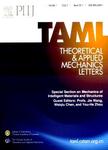Second-order relative exponent of isotropic turbulence
Second-order relative exponent of isotropic turbulence作者机构:Shanghai Institute of Applied Mathematics and Mechanics Shanghai University Shanghai 200072 China
出 版 物:《Theoretical & Applied Mechanics Letters》 (力学快报(英文版))
年 卷 期:2011年第1卷第3期
页 面:74-77页
学科分类:081704[工学-应用化学] 08[工学] 0831[工学-生物医学工程(可授工学、理学、医学学位)] 0830[工学-环境科学与工程(可授工学、理学、农学学位)] 0707[理学-海洋科学] 0817[工学-化学工程与技术] 0815[工学-水利工程] 0805[工学-材料科学与工程(可授工学、理学学位)] 081701[工学-化学工程] 0813[工学-建筑学] 0824[工学-船舶与海洋工程] 0802[工学-机械工程] 0836[工学-生物工程] 0814[工学-土木工程] 0825[工学-航空宇航科学与技术] 0701[理学-数学] 0801[工学-力学(可授工学、理学学位)] 0702[理学-物理学]
基 金:supported by the National Natural Science Foundation of China(90816013,10572083) also supported by State Key Laboratory for Turbulence and Complex System
主 题:isotropic turbulence structure function EES scaling exponent
摘 要:Theoretical results on the scaling properties of turbulent velocity fields are reported in this *** on the Kolmogorov equation and typical models of the second-order statistical moments (energy spectrum and the second-order structure function),we have studied the relative scaling using the ESS *** is found that the relative EES scaling exponent Sis greater than the real or theoretical inertial range scaling exponentξ,which is attributed to an evident bump in the ESS range.



